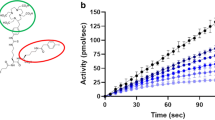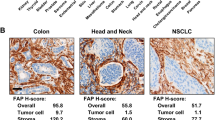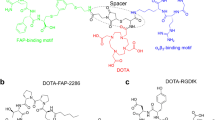Abstract
Purpose
Fibroblast activation protein is one of the most attractive targets for tumor diagnosis and therapy. There have been many successful clinical translations with small molecules and peptides, yet only a few anti-FAP antibody diagnostic or therapeutic agents have been reported. Antibodies often feature good tumor selectivity and long tumor retention, which may be a better-match with therapeutic radionuclides (e.g.,177Lu, 225Ac) for cancer therapy. Here we report a 177Lu-labeled anti-FAP antibody, PKU525, as a therapeutic radiopharmaceutical for FAP-targeted radiotherapy.
Methods
The anti-FAP antibody is produced as a derivative of sibrotuzumab. The pharmacokinetics and blocking study are performed with 89Zr-labeled antibody by PET imaging. The conjugation strategies have been screened and tested with SPECT imaging through 177Lu-labeling. The biodistribution and radiotherapy studies are performed on 177Lu-labeled anti-FAP antibody in NU/NU mice-bearing HT-1080-FAP tumors.
Results
A multiple time-point PET imaging study shows that the tumor accumulation of [89Zr]Zr-DFO-PKU525 is intense, selective, and relatively rapid. The time activity curve indicates that the tumor uptake continually increases until reaches the highest uptake (SUVmax = 18.4 ± 2.3, n = 4) at 192 h, then gradually declines. Radioactivity rapidly cleared from the blood, liver, and other major organs, resulting in high tumor-to-background ratios. An in vivo blocking experiment suggests that [89Zr]Zr-DFO-PKU525 is FAP-specific and the uptake in FAP-negative tumors is almost negligible. Ex vivo biodistribution study shows that the tumor uptake of [177Lu]Lu-DOTA-NCS-PKU525 is 23.04 ± 5.11% ID/g, 33.2 ± 6.36% ID/g, 19.87 ± 6.84% ID/g and 19.02 ± 5.90% ID/g at 24 h, 96 h, 168 h, and 240 h after injection (n = 5), which is corroborated with the PET imaging. In therapeutic assays, multiple doses of [177Lu]Lu-DOTA-NCS-PKU525 have been tested in tumor-bearing mice, and the data suggests that 3.7 MBq may be sufficient to completely suppress the tumor growth in mice without showing observable side effects.
Conclusion
A FAP-targeted antibody-radionuclide conjugate was developed and evaluated in vitro and in vivo. Its tumor accumulation is rapid and high with a clean background. It remarkably suppresses the tumors in mice while the side effect is almost negligible, showing that it is promising for further clinical translational studies.






Similar content being viewed by others
Data Availability
The datasets generated during and/or analyzed during the current study are available from the corresponding author on reasonable request.
References
Bhowmick NA, Neilson EG, Moses HL. Stromal fibroblasts in cancer initiation and progression. Nature. 2004;432:332–7. https://doi.org/10.1038/nature03096.
Hwang RF, Moore T, Arumugam T, Ramachandran V, Amos KD, Rivera A, et al. Cancer-associated stromal fibroblasts promote pancreatic tumor progression. Cancer Res. 2008;68:918–26. https://doi.org/10.1158/0008-5472.Can-07-5714.
Karnoub AE, Dash AB, Vo AP, Sullivan A, Brooks MW, Bell GW, et al. Mesenchymal stem cells within tumour stroma promote breast cancer metastasis. Nature. 2007;449:557–63. https://doi.org/10.1038/nature06188.
Teichgraber V, Monasterio C, Chaitanya K, Boger R, Gordon K, Dieterle T, et al. Specific inhibition of fibroblast activation protein (FAP)-alpha prevents tumor progression in vitro. Adv Med Sci. 2015;60:264–72. https://doi.org/10.1016/j.advms.2015.04.006.
Huang S, Fang R, Xu J, Qiu S, Zhang H, Du J, et al. Evaluation of the tumor targeting of a FAPalpha-based doxorubicin prodrug. J Drug Target. 2011;19:487–96. https://doi.org/10.3109/1061186X.2010.511225.
Bughda R, Dimou P, D’Souza RR, Klampatsa A. Fibroblast activation protein (FAP)-targeted CAR-T cells: launching an attack on tumor stroma. Immunotargets Ther. 2021;10:313–23. https://doi.org/10.2147/ITT.S291767.
Tanswell P, Garin-Chesa P, Rettig WJ, Welt S, Divgi CR, Casper ES, et al. Population pharmacokinetics of antifibroblast activation protein monoclonal antibody F19 in cancer patients. Br J Clin Pharmacol. 2001;51:177–80. https://doi.org/10.1111/j.1365-2125.2001.01335.x.
Chen H, Zhao L, Ruan D, Pang Y, Hao B, Dai Y, et al. Usefulness of [(68)Ga]Ga-DOTA-FAPI-04 PET/CT in patients presenting with inconclusive [(18)F]FDG PET/CT findings. Eur J Nucl Med Mol Imaging. 2021;48:73–86. https://doi.org/10.1007/s00259-020-04940-6.
Zhao L, Pang Y, Zheng H, Han C, Gu J, Sun L, et al. Clinical utility of [(68)Ga]Ga-labeled fibroblast activation protein inhibitor (FAPI) positron emission tomography/computed tomography for primary staging and recurrence detection in nasopharyngeal carcinoma. Eur J Nucl Med Mol Imaging. 2021;48:3606–17. https://doi.org/10.1007/s00259-021-05336-w.
Kratochwil C, Flechsig P, Lindner T, Abderrahim L, Altmann A, Mier W, et al. (68)Ga-FAPI PET/CT: tracer uptake in 28 different kinds of cancer. J Nucl Med. 2019;60:801–5. https://doi.org/10.2967/jnumed.119.227967.
Giesel FL, Heussel CP, Lindner T, Rohrich M, Rathke H, Kauczor HU, et al. FAPI-PET/CT improves staging in a lung cancer patient with cerebral metastasis. Eur J Nucl Med Mol Imaging. 2019;46:1754–5. https://doi.org/10.1007/s00259-019-04346-z.
Lindner T, Giesel FL, Kratochwil C, Serfling SE. Radioligands targeting fibroblast activation protein (FAP). Cancers (Basel). 2021;13. https://doi.org/10.3390/cancers13225744.
Ferdinandus J, Costa PF, Kessler L, Weber M, Hirmas N, Kostbade K, et al. Initial clinical experience with (90)Y-FAPI-46 radioligand therapy for advanced-stage solid tumors: a case series of 9 patients. J Nucl Med. 2022;63:727–34. https://doi.org/10.2967/jnumed.121.262468.
Calais J. FAP: the next billion dollar nuclear theranostics target? J Nucl Med. 2020;61:163–5. https://doi.org/10.2967/jnumed.119.241232.
Gudkov SV, Shilyagina NY, Vodeneev VA, Zvyagin AV. Targeted radionuclide therapy of human tumors. Int J Mol Sci. 2016;17:33.
Garin-Chesa P, Old LJ, Rettig WJ. Cell surface glycoprotein of reactive stromal fibroblasts as a potential antibody target in human epithelial cancers. Proc Natl Acad Sci U S A. 1990;87:7235–9. https://doi.org/10.1073/pnas.87.18.7235.
Fendler WP, Pabst KM, Kessler L, Fragoso Costa P, Ferdinandus J, Weber M, et al. Safety and efficacy of 90Y-FAPI-46 radioligand therapy in patients with advanced sarcoma and other cancer entities. Clin Cancer Res. 2022;28:4346–53. https://doi.org/10.1158/1078-0432.CCR-22-1432.
Ballal S, Yadav MP, Moon ES, Kramer VS, Roesch F, Kumari S, et al. First-in-human results on the biodistribution, pharmacokinetics, and dosimetry of [(177)Lu]Lu-DOTA.SA.FAPi and [(177)Lu]Lu-DOTAGA.(SA.FAPi)(2). Pharmaceuticals (Basel). 2021;14. https://doi.org/10.3390/ph14121212.
Zhao L, Niu B, Fang J, Pang Y, Li S, Xie C, et al. Synthesis, preclinical evaluation, and a pilot clinical PET imaging study of (68)Ga-labeled FAPI dimer. J Nucl Med. 2022;63:862–8. https://doi.org/10.2967/jnumed.121.263016.
Zboralski D, Hoehne A, Bredenbeck A, Schumann A, Nguyen M, Schneider E, et al. Preclinical evaluation of FAP-2286 for fibroblast activation protein targeted radionuclide imaging and therapy. Eur J Nucl Med Mol Imaging. 2022. https://doi.org/10.1007/s00259-022-05842-5.
Baum RP, Schuchardt C, Singh A, Chantadisai M, Robiller FC, Zhang J, et al. Feasibility, biodistribution, and preliminary dosimetry in peptide-targeted radionuclide therapy of diverse adenocarcinomas using (177)Lu-FAP-2286: first-in-humans results. J Nucl Med. 2022;63:415–23. https://doi.org/10.2967/jnumed.120.259192.
Ballal S, Yadav MP, Kramer V, Moon ES, Roesch F, Tripathi M, et al. A theranostic approach of [(68)Ga]Ga-DOTA.SA.FAPi PET/CT-guided [(177)Lu]Lu-DOTA.SA.FAPi radionuclide therapy in an end-stage breast cancer patient: new frontier in targeted radionuclide therapy. Eur J Nucl Med Mol Imaging. 2021;48:942–4. https://doi.org/10.1007/s00259-020-04990-w.
Kratochwil C, Giesel FL, Rathke H, Fink R, Dendl K, Debus J, et al. [Sm-153]Samarium-labeled FAPI-46 radioligand therapy in a patient with lung metastases of a sarcoma. Eur J Nucl Med Mol. 2021;I(48):3011–3. https://doi.org/10.1007/s00259-021-05273-8.
Watabe T, Liu Y, Kaneda-Nakashima K, Shirakami Y, Lindner T, Ooe K, et al. Theranostics targeting fibroblast activation protein in the tumor stroma: (64)Cu- and (225)Ac-labeled FAPI-04 in pancreatic cancer xenograft mouse models. J Nucl Med. 2020;61:563–9. https://doi.org/10.2967/jnumed.119.233122.
Liu Y, Watabe T, Kaneda-Nakashima K, Shirakami Y, Naka S, Ooe K, et al. Fibroblast activation protein targeted therapy using [(177)Lu]FAPI-46 compared with [(225)Ac]FAPI-46 in a pancreatic cancer model. Eur J Nucl Med Mol Imaging. 2022;49:871–80. https://doi.org/10.1007/s00259-021-05554-2.
Xu M, Zhang P, Ding J, Chen J, Huo L, Liu Z. Albumin binder-conjugated fibroblast activation protein inhibitor radiopharmaceuticals for cancer therapy. J Nucl Med. 2022;63:952–8. https://doi.org/10.2967/jnumed.121.262533.
Wen X, Xu P, Shi M, Liu J, Zeng X, Zhang Y, et al. Evans blue-modified radiolabeled fibroblast activation protein inhibitor as long-acting cancer therapeutics. Theranostics. 2022;12:422–33. https://doi.org/10.7150/thno.68182.
Younis MH, Malih S, Lan XL, Rasaee MJ, Cai WB. Enhancing fibroblast activation protein (FAP)-targeted radionuclide therapy with albumin binding, and beyond. Eur J Nucl Med Mol. 2022;I(49):1773–7. https://doi.org/10.1007/s00259-022-05766-0.
Millul J, Bassi G, Mock J, Elsayed A, Pellegrino C, Zana A, et al. An ultra-high-affinity small organic ligand of fibroblast activation protein for tumor-targeting applications. Proc Natl Acad Sci U S A. 2021;118. https://doi.org/10.1073/pnas.2101852118.
Dash A, Knapp FF, Pillai MR. Targeted radionuclide therapy–an overview. Curr Radiopharm. 2013;6:152–80. https://doi.org/10.2174/18744710113066660023.
Milenic DE, Brady ED, Brechbiel MW. Antibody-targeted radiation cancer therapy. Nat Rev Drug Discovery. 2004;3:488–99. https://doi.org/10.1038/nrd1413.
Rettig WJ, Garin-Chesa P, Beresford HR, Oettgen HF, Melamed MR, Old LJ. Cell-surface glycoproteins of human sarcomas: differential expression in normal and malignant tissues and cultured cells. Proc Natl Acad Sci U S A. 1988;85:3110–4. https://doi.org/10.1073/pnas.85.9.3110.
Scott AM, Wiseman G, Welt S, Adjei A, Lee FT, Hopkins W, et al. A Phase I dose-escalation study of sibrotuzumab in patients with advanced or metastatic fibroblast activation protein-positive cancer. Clin Cancer Res. 2003;9:1639–47.
Hofheinz RD, al-Batran SE, Hartmann F, Hartung G, Jager D, Renner C, et al. Stromal antigen targeting by a humanised monoclonal antibody: an early phase II trial of sibrotuzumab in patients with metastatic colorectal cancer. Onkologie. 2003;26:44–8. https://doi.org/10.1159/000069863.
Nadal L, Peissert F, Elsayed A, Weiss T, Look T, Weller M, et al. Generation and in vivo validation of an IL-12 fusion protein based on a novel anti-human FAP monoclonal antibody. J Immunother Cancer. 2022;10. https://doi.org/10.1136/jitc-2022-005282.
Fabre M, Ferrer C, Domínguez-Hormaetxe S, Bockorny B, Murias L, Seifert O, et al. OMTX705, a novel FAP-targeting ADC demonstrates activity in chemotherapy and pembrolizumab-resistant solid tumor models. Clin Cancer Res. 2020;26:3420–30. https://doi.org/10.1158/1078-0432.Ccr-19-2238.
Fischer E, Chaitanya K, Wuest T, Wadle A, Scott AM, van den Broek M, et al. Radioimmunotherapy of fibroblast activation protein positive tumors by rapidly internalizing antibodies. Clin Cancer Res. 2012;18:6208–18. https://doi.org/10.1158/1078-0432.CCR-12-0644.
Laverman P, van der Geest T, Terry SY, Gerrits D, Walgreen B, Helsen MM, et al. Immuno-PET and immuno-SPECT of rheumatoid arthritis with radiolabeled anti-fibroblast activation protein antibody correlates with severity of arthritis. J Nucl Med. 2015;56:778–83. https://doi.org/10.2967/jnumed.114.152959.
Rousseau E, Lau J, Zhang Z, Uribe CF, Kuo HT, Zhang C, et al. Effects of adding an albumin binder chain on [(177)Lu]Lu-DOTATATE. Nucl Med Biol. 2018;66:10–7. https://doi.org/10.1016/j.nucmedbio.2018.08.001.
Zhang P, Xu M, Ding J, Chen J, Zhang T, Huo L, et al. Fatty acid-conjugated radiopharmaceuticals for fibroblast activation protein-targeted radiotherapy. Eur J Nucl Med Mol Imaging. 2022;49:1985–96. https://doi.org/10.1007/s00259-021-05591-x.
Pandya DN, Sinha A, Yuan H, Mutkus L, Stumpf K, Marini FC, et al. Imaging of fibroblast activation protein alpha expression in a preclinical mouse model of glioma using positron emission tomography. Molecules. 2020;25. https://doi.org/10.3390/molecules25163672.
Hintz HM, Gallant JP, Vander Griend DJ, Coleman IM, Nelson PS, LeBeau AM. Imaging fibroblast activation protein alpha improves diagnosis of metastatic prostate cancer with positron emission tomography. Clin Cancer Res. 2020;26:4882–91. https://doi.org/10.1158/1078-0432.Ccr-20-1358.
Price EW, Orvig C. Matching chelators to radiometals for radiopharmaceuticals. Chem Soc Rev. 2014;43:260–90. https://doi.org/10.1039/c3cs60304k.
Liu Y, Tang H, Song T, Xu M, Chen J, Cui XY, et al. Organotrifluoroborate enhances tumor targeting of fibroblast activation protein inhibitors for targeted radionuclide therapy. Eur J Nucl Med Mol Imaging. 2023. https://doi.org/10.1007/s00259-023-06230-3.
Matsuda Y. Current approaches for the purification of antibody-drug conjugates. J Sep Sci. 2022;45:27–37. https://doi.org/10.1002/jssc.202100575.
Watabe T, Liu YW, Kaneda-Nakashima K, Shirakami Y, Lindner T, Ooe K, et al. Theranostics targeting fibroblast activation protein in the tumor stroma: Cu-64- and Ac-225-labeled FAPI-04 in pancreatic cancer xenograft mouse models. J Nucl Med. 2020;61:563–9. https://doi.org/10.2967/jnumed.119.233122.
Costa PF, Jentzen W, Pabst KM, Kessler L, Ferdinandus J, Weber M, et al. First-in-man Y-90-FAPI-46 PET/CT based tumour dosimetry in radioligand therapy of advanced stage solid tumours. Eur J Nucl Med Mol. 2022;I(49):S390-S.
Ding J, Xu M, Chen J, Zhang P, Huo L, Kong Z, et al. 86Y-labeled albumin-binding fibroblast activation protein inhibitor for late-time-point cancer diagnosis. Mol Pharm. 2022;19:3429–38. https://doi.org/10.1021/acs.molpharmaceut.2c00579.
Liu Z, Chen X. Simple bioconjugate chemistry serves great clinical advances: albumin as a versatile platform for diagnosis and precision therapy. Chem Soc Rev. 2016;45:1432–56. https://doi.org/10.1039/c5cs00158g.
Acknowledgements
We thank the facility support from the Analytical Instrumentation Center of Peking University.
Funding
This study was funded by the Beijing Municipal Natural Science Foundation (Grant No. Z200018), the National Natural Science Foundation of China (Grant No. 22225603), the Ministry of Science and Technology of the People’s Republic of China (Grant Nos. 2021YFA1601400), and Changping Laboratory under the project number (2022C-07-01), the Central Guidance for Local Science and Technology Development Projects (No. 202138-03) to Z.L.
Author information
Authors and Affiliations
Corresponding authors
Ethics declarations
Competing interests
Pu Zhang, Mengxin Xu, Junyi Chen, and Zhibo Liu are the consultants of Boomray Pharmaceuticals (Beijing) Co., Ltd.
Additional information
Publisher's note
Springer Nature remains neutral with regard to jurisdictional claims in published maps and institutional affiliations.
Supplementary Information
Below is the link to the electronic supplementary material.
Rights and permissions
Springer Nature or its licensor (e.g. a society or other partner) holds exclusive rights to this article under a publishing agreement with the author(s) or other rightsholder(s); author self-archiving of the accepted manuscript version of this article is solely governed by the terms of such publishing agreement and applicable law.
About this article
Cite this article
Xu, M., Chen, J., Zhang, P. et al. An antibody-radionuclide conjugate targets fibroblast activation protein for cancer therapy. Eur J Nucl Med Mol Imaging 50, 3214–3224 (2023). https://doi.org/10.1007/s00259-023-06300-6
Received:
Accepted:
Published:
Issue Date:
DOI: https://doi.org/10.1007/s00259-023-06300-6




